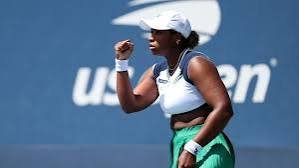
Introduction
In a drama-filled showdown on August 27, 2025, at the U.S. Open, American tennis standout Taylor Townsend delivered a striking upset over Latvia’s Grand Slam champion Jelena Ostapenko, winning 7–5, 6–1. What seemed like a celebratory moment instantly escalated into a bitter confrontation—making the matches more about sportsmanship than scorelines.
1. Background: Townsend’s Formidable Journey in 2025
A. Doubles Dominance
Taylor Townsend has had an exceptional year:
-
She captured her second Grand Slam doubles title at the Australian Open, partnering Katerina Siniaková and defeating Ostapenko and Hsieh Su-wei.
-
The duo repeated triumph at the Dubai Tennis Championships, again overcoming Ostapenko and Hsieh in the final Wikipedia.
-
These performances vaulted her to World No. 1 in doubles, marking her as the first mother on tour to reach that ranking.
B. Singles Surge
While Townsend shines in doubles, her singles journey has been more oscillating. Ranked No. 139, her victory today marks a rare Grand Slam singles third-round appearance—the first since 2023.
2. Match Recap: Townsend vs Ostapenko
On Court 11, the match began with Ostapenko holding early momentum. She surged to a 3-0 lead and later served at 5-3 in the first set. Yet Townsend battled back, flipping the score to win 7-5. She carried that energy into the second set, dominating and closing it 6-1.
3. The Post-Match Confrontation
A. At the Net
After the match, tension unfolded at the post-match handshake. Ostapenko reportedly accused Townsend of being disrespectful—for not apologizing after a net-cord point—and began pointing her finger while voicing complaints.
B. Words That Sparked Debate
Ostapenko’s criticism was harsh:
-
She said Townsend had “no class” and “no education.”
-
Ostapenko ominously added, “see what happens if we play each other outside of the U.S.”
This ignited controversy—many raised questions about whether such words carried racial overtones, especially given Townsend’s identity and the social stigma tying Black athletes to assumptions about education.
C. Townsend’s Composed Response
In her post-match press conference, Townsend remained dignified:
-
She said she didn’t interpret the remarks as racist but acknowledged stereotypes at play.
-
“I let my racket talk,” she declared, emphasizing her focus on performance.
-
On social media, Ostapenko denied being racist, defending her words as rooted in etiquette—not race.
D. Widening the Etiquette Debate
At the heart: unwritten tennis etiquette. Ostapenko criticized Townsend for:
-
Not apologizing after a net cord point.
-
Starting warm-up volleys at the net instead of baseline—a deviation from tradition.
While unwritten, such customs are widely respected in tennis. Some players, however, like Taylor Fritz and Ben Shelton, have publicly downplayed their importance.
4. Broader Significance: Etiquette, Cultural Context, and Respect
A. Tradition vs. Modernity
This incident raises a key question: Should unwritten rules dictate sports conduct? Ostapenko sees them as foundational; Townsend—and many others—see them as outdated in modern sport.
B. The Race Dimension
While Townsend didn’t brand Ostapenko’s words as racist, she highlighted how “education” can be a dog-whistle term when directed at Black individuals. The comment reignited discourse on implicit bias in sports commentary.
C. Spotlight on Player Behavior
While towering personalities are not uncommon in tennis, viewers expect respect on and off court. Ostapenko’s fiery outcry—though undeniably dramatic—shifted the spotlight from a powerful performance to player conduct.
5. What’s Next for Townsend and Ostapenko
A. For Townsend
-
She advances to the third round, where she’ll face No. 5 seed Mirra Andreeva.
-
Her strength lies in maintaining composure and letting performance define her narrative.
B. For Ostapenko
-
Ostapenko—visibly upset—promptly addressed the backlash on Instagram, insisting she wasn’t driven by racism and reaffirming her enthusiasm to “come back stronger”.
6. Final Thoughts: Competition, Culture, and Civility
Taylor Townsend vs Ostapenko isn’t just a match—it’s a clash of traditions, identities, and expectations. Townsend, a rising force in doubles and an improving singles competitor, held her ground both on the scoreboard and in dialogue. Meanwhile, Ostapenko’s puzzle of etiquette, impatience, and heightened emotion added layers to an already charged event.
As tennis evolves, the intersection of performance, personality, and perception will define its trajectory. For Townsend, her response was methodical and measured. For Ostapenko, the aftermath will either stand as a cautionary moment or fuel future intensity.
